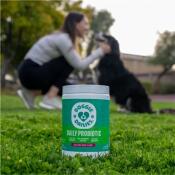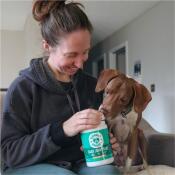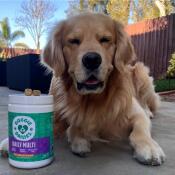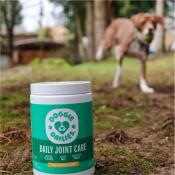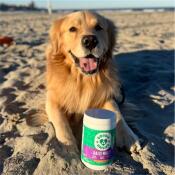A loyal friend, a powerful protector, and a goofy source of entertainment around the house — these and other fine qualities describe the amazing breed of dog known as the Rottweiler. These large, muscular dogs have a gentle side that blooms under the proper care and training. Take a look at what Rottweiler's are all about!
"A loyal friend, a powerful protector, and a goofy source of entertainment around the house..."
Breed Of The Month: Rottweiler
-
Rottweiler Breed Overview
Rottweilers offer more versatility as a breed than you might assume simply by looking at their impressive size and their reputation as guard animals and working dogs. You can definitely benefit from your Rottweiler's protective streak, but you'll also find that you can turn that Rottie into a fun-loving family pet, a gentle giant with a heart of gold. Just keep in mind that you're getting a big, strong pooch who loves to bump up against people to show affection for them!
-
History and Background
Rottweilers originated in ancient Rome as an offshoot of Mastiff-like Italian Molossus. Molossus dogs worked hard for their living, fighting lions in amphitheaters and driving cattle for soldiers as they marched across long distances. These conquering Romans established a town in Germany called Arae Flaviae, later called Rottweil by the locals. In this location, the breed we recognize as the Rottweiler became an essential working animal, pulling carts, bringing herds of cattle to butchers, and then protecting those same butchers against attacks.
The Rottweiler breed almost died out as its draft-animal role grew less and less important. However, German breeders rescued it in the early 20th Century for its value in police work. By the late 1920s, Rottweilers had found their way to American shores.
-
Physical Characteristics
Once you've laid eyes on a Rottweiler, you'll never have trouble identifying one again. These massive dogs typically stand 22 to 27 inches tall (measured at the shoulder), with a body slightly longer than its height and a chest depth ranging around 50 percent of the measured height. The weight matches these dimensions. You can expect the average Rottweiler to weigh from 75 to 110 pounds, but some giants can tip the scale (assuming they don't actually break said scale) at 135 pounds!
Rottweilers feature a double coat of black fur, with the coarse outer coat usually hiding the underlying coat. Tan or brown markings decorate the muzzle, eyebrows, chest, bottom, and legs.
-
Personality
Rottweilers show great love and loyalty to their owners or adoptive families, but they can seem rather aloof around strangers. Their loyalty can take the form of extreme protectiveness against anyone who appears to threaten the Rottweiler's beloved humans. While this quality makes Rottweilers terrific watchdogs and police dogs, a deeper quality of calmness and gentleness makes them sweet, caring pets when properly trained.
As an intelligent working dog, the Rottweiler prefers having a task to perform. Rottweilers left to their own devices can get bored or anxious, which may then lead them to dig up your garden or chew your furniture.
-
How to Care for Your Rottweiler
As you imagine with such a smart, task-oriented, protective breed, training and socialization make all the difference in keeping your Rottweiler happy and well-adjusted. Thankfully, these dogs respond beautifully to firm, thorough training, which they enjoy as a series of interesting challenges. Make sure you teach your massive friend not to jump up on or bump into kids or fragile adults.
Rottweiler puppies have a lot of growing to do, while adult Rottweilers burn a lot of calories in their daily activities. Make sure that your puppy's diet includes 24 to 28 percent protein. You can drop that number to around 22 to 26 percent for an adult Rottie. Ask your veterinarian to recommend specific portions sizes and food products for your individual dog, since Rottweilers love to eat and can gain excess weight easily.
-
Potential Health Issues
Like any breed of dog, Rottweilers can develop health problems. Watch out for hip dysplasia, elbow dysplasia, and bone or cartilage problems. These plus-sized canines can also suffer from a twisting of the stomach called bloat. Some Rottweilers can also have retinal problems that affect their vision.
-
Fun Facts About the Breed
The American Kennel Club ranks the Rottweiler as the 11th most popular breed in the U.S. But in the city of Detroit, it actually ranks as the most popular of all dog breeds.
Rottweilers came to the rescue following the tragedy of September 11, 2001, when they searched the Twin Towers area for survivors alongside other classic service breeds such as German Shepherd Dogs.
-
Famous Rottweilers
Hollywood likes to stereotype Rottweilers in their roles as fierce guard dogs, but even these portrayals include room for comedy. Remember Ferris Bueller’s Rottweiler who chased the student dean through the house?
Singer/songwriter Bruno Mars has made his Rottweiler, Geronimo, into an Internet celebrity.
Indo, Zhaki, and three other lucky Rotties consider themselves part of A-list actor Will Smith's family.
-
Rottweilers to Follow on Instagram
Murphy stands as the most visible Rottie on Instagram, with 446,000 followers.
If you can't get enough Rottweilers, follow Logan, JJ, Roman, Stan, and Kaizer.
Watch Banzai enjoy fun in the sun on the Spanish island of Mallorca.
-
What to Expect From Rottweiler Ownership
Your Rottweiler can give your family years of companionship, security, and love. Just make sure you give it plenty of training and socialization, look after its potential health issues, and give it the freedom to indulge its working-dog tendencies, and you'll enjoy a wonderful life with your new friend!

